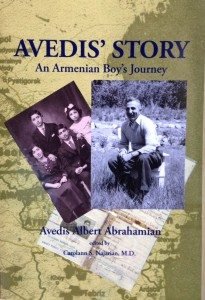“The struggle of man against power is the struggle
of memory against forgetting.” —Milan Kundera
Special for the Armenian Weekly
On the eve of the Genocide Centennial, as individuals and institutions work to raise awareness and enrich knowledge of the Armenian Genocide, a treasure trove of scholarly works, memoirs, novels, and collections of letters is being published.

A valuable addition to this bookshelf is Avedis Albert Abrahamian’s memoir Avedis’ Story: An Armenian Boy’s Journey, edited by his daughter, Carolann S. Najarian, and published by the Gomidas Institute.
The memoir, based on an audio tape recording from 35 years ago, opens with life in the village of Sheykh Hadji in Kharpert. Abrahamian describes his family and life in the village, particularly in the Armenian quarter, which was in verin (upper) Sheykh Hadji (currently, yukarı bağ). The opening section is rich with details and anecdotes that reconstruct life in Sheykh Hadji before the genocide, including the traditions, culture, and power relations with the village beg and local Muslims.
It is worth noting here that Ottoman census records published in the 1894 salname (yearbook) for Mamurat ul -Aziz (Mezre) indicate that Sheykh Hadji had 188 households (600 Armenians and 445 Muslims). Abrahamian provides a slightly lower figure of 150 households for the village.
His grandmother, Anna Baji, stands out in the section as a “smart, strong, and fearless” matriarch. (We learn about her death on the deportation route in the next chapter.)
The chapter detailing the Abrahamians’ escape during the genocide is the centerpiece of the memoir. Told powerfully and vividly is the fate of the males in the village, the deportation of the women and children, and the suicides by desperate widows, as well as the Abrahamians’ life in hiding at the German orphanage in nearby Mezre, their eventual escape via Dersim to Russian-controlled Yerzinga (Erzincan) and then Drabizon (Trabzon) in 1916, and the treacherous journey that eventually led them to post-war Constantinople in 1920 and, finally, to the United States a year later.
The final chapter, which depicts their life in America, concludes with poignant words that will resonate with many survivors and their descendants: “The past was buried, but could never be forgotten.” Avedis Abrahamian’s story contributes to that struggle of memory against forgetting.
—By K.M.


Be the first to comment